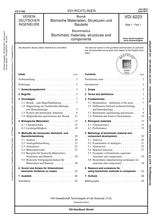Standards Worldwide
Standards Worldwide
Phone +49 30 58885700-07

Technical rule [CURRENT]
VDI 6223 Blatt 1:2013-06
Biomimetics - Biomimetic materials, structures and components
- German title
- Bionik - Bionische Materialien, Strukturen und Bauteile
- Publication date
- 2013-06
- Original language
- German, English
- Pages
- 51
- Publication date
- 2013-06
- Original language
- German, English
- Pages
- 51
Product information on this site:
Quick delivery via download or delivery service
Buy securely with a credit card or pay upon receipt of invoice
All transactions are encrypted
Short description
The successful application of biomimetics is characterized by a creative transfer of knowledge and ideas from biology to technology. The field of biomimetics is highly interdisciplinary, which is indicated by the high level of cooperation between experts from different fields of research, for example between biologists, chemists, physicists, and engineers. The increasing complexity of technical solutions and products requires new approaches. Classic research and development methods and innovation approaches often reach their limits, especially in the development and optimization of materials, structures, and components. The identification of suitable biological principles and their transfer to technical applications therefore can make an important contribution to the development of functional, adaptive, efficient (in terms of resources), and safe (in terms of toxicity to humans and the environment) materials, structures, and components. Important terms in biomimetics focusing on the development of materials, structures, and components are defined. The principles of success of biological models, and especially the performance of biological materials and structures that provide the motivation and reasons for bionic approaches, are illustrated. The methodology is illustrated based on the phases of the analysis of the biological model, analogy, and abstraction. The transfer process from biology to technology is described based on examples of bionic manufacturing techniques, materials, and components. Furthermore details are given on the relevance of bionic materials, structures, and components to industry. The contents of the guideline are intended for developers of materials and components in all branches of industry. The guideline also points out numerous links to other subareas in biomimetics because innovations in materials, structures, and components often form the basis for a wide variety of additional new developments.
Content
ICS
07.080
Also available in
Loading recommended items...
Loading recommended items...
Loading recommended items...
Loading recommended items...
